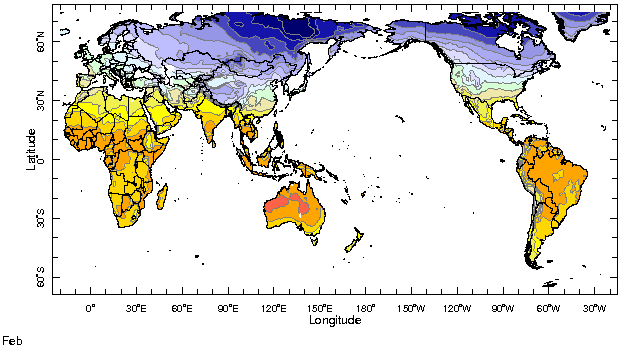|
IRI Climate Digest
March 2003
February Global Climate Summary
Climatological Background
In February, the sun is retreating from its southernmost excursion (23 degrees south) on its approach toward the equator in mid-March (the equinox). It is the end of summer in the Southern Hemisphere, and the monsoon systems typically achieve their maximum intensity in Africa, Australia, Indonesia, and South America. Winter in the Northern Hemisphere generally peaks, with the north-south temperature differences beginning to drive the mid-latitude jet stream northward.
Monthly Mean Temperature (1961-1990), data from the Climate Research
Unit, University of East Anglia


Monthly Mean Precipitation (1961-1990), data from the Climate Research
Unit, University of East Anglia


Temperatures
Highlights
Above-normal temperatures intensified in Alaska and northwestern Canada, dominating that region's weather for the sixth straight month. Higher-than-normal temperatures also prevailed over much of Asia and South America and enhanced the drought conditions in southern and western Africa. A four-month long cold spell in Scandinavia was broken by above-normal temperatures as well. Much of eastern North America and central and eastern Europe experienced below-normal temperatures in February.
Temperature Difference from the 1961-1990 mean, with data
from NCEP Climate Prediction Center, CAMS.


Precipitation
Highlights
Precipitation patterns typically associated with El Niņo began to wane during February as sea surface temperature anomalies weakened in the tropical Pacific Ocean.
Africa: Much of southern and eastern Africa continued to experience drier-than-normal conditions, although portions of Angola, DRC, Zambia, Malawi, and Mozambique experienced above-normal rainfall.
South America: Central Brazil extended its current dry spell another month while Peru, Uruguay, eastern Argentina and extreme northern and southern Brazil experienced unusually wet conditions.
Indonesia/Australia: Wetter-than-normal conditions became more widespread in Indonesia and eased drought conditions in portions of Australia.
Europe: Nearly all of Europe experienced below-normal precipitation in February.
Precipitation Difference from 1961-1990 mean, with data
from NCEP Climate Prediction Center, CAMS-OPI.


Oceanic Conditions
Tropical Pacific: Above-average sea surface temperatures associated with El Niņo continued to weaken with respect to normal in the central and eastern tropical Pacific Ocean in February. The area of above-normal SSTs has continued to contract. The greatest departures from normal of about 1.5°C were confined to a region near 180° longitude in the tropical Pacific. The El Niņo is expected to continue to weaken over the coming months. See the latest IRI ENSO Update for a detailed summary and outlook.
Tropical Atlantic: SSTs generally remained near-normal in the tropical Atlantic in February, although there was some cooling with respect to normal conditions in the eastern North Atlantic off the coast of West Africa, and warming with respect to normal along the coast of Angola from January to February.
Indian Ocean: Warmer-than-normal SSTs developed in the western Indian Ocean along much of the coast of Africa in February. SSTs remained above-normal throughout much of the rest of the Indian Ocean although some warm departures were eroded somewhat in the southern Indian Ocean.
Mid-latitudes: Cooler-than-normal SSTs developed around New Zealand in February. In the southern Atlantic Ocean SSTs warmed with respect to normal in the western half of the basin and cooled in the eastern half. Cool departures from normal in the northern central Pacific Ocean weakened slightly in February.
Monthly Sea Surface Temperature Difference from the 1950-1979 mean,
with data from the Environmental Modeling Center, NCEP/NOAA.


Contents |
Special |
Impacts |
Climate |
Forecast
| 
